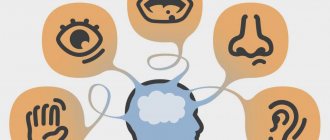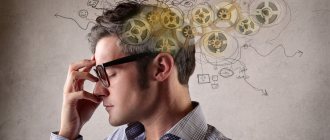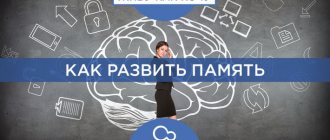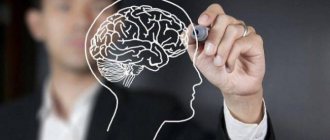Today, almost everyone has a computer. Just for the sake of curiosity, look at how much memory it has. On average, the RAM is 4-8 gigabytes, the hard drive is from 500 to 2000 gigabytes. If we compare the human brain with this machine, it can store 1 million gigabytes of information. This fact alone indicates the uniqueness of this mental process. Memory is considered one of the most studied areas, but it still holds many secrets, which many minds continue to work to uncover.
General classification
There are a large number of classifications of memory in domestic and foreign psychology.
If you need to study this material in detail, you should look at the works of P. P. Blonsky, R. S. Nemov, F. N. Shemyakin, D. O. Hebb and other specialists. There are only the main types; psychology identifies the following:
In fact, in addition to the main types of memory, descriptions of others can be found in the works of psychologists. For example, the classification according to the nature of mental activity sometimes also includes:
- sensory - visual, when fixation occurs at the moment of blinking;
- eidetic - combined, when visual impressions (which form its basis) are reinforced by others (auditory, gustatory, tactile), which allows subsequently to reproduce an unusually vivid image;
- social - preservation of socially significant information accumulated by previous generations;
- spatial - visual, allowing you to navigate the area well, remembering the features of the route.
The classification by duration is expanded by such a type as ultra-short-term memory (another name is the sensory register) - retaining information for several seconds. Includes iconic (for fixing visual material, lasts less than a second) and echoic (for acoustic, lasts 2 seconds).
Some psychologists classify types of memory into a separate group based on the type of organization of memorization:
- episodic - storage of specific information limited to a certain period (about a concert, for example);
- procedural (automatic) - a way of performing an action without taking into account its content, through skills brought to automaticity (driving skill).
Within each typology, several more species are distinguished. Psychologists are actively engaged in their classification to this day, constantly expanding and improving it.
Individual differences in memory in humans
Differences in memory can be explained by what type of memory is used most often. They are also influenced by the nature of the work performed and the characteristics of daily activities.
A striking example is researchers. They have developed semantic and logical types of memory, while the level of development of mechanical memory suffers.
All processes associated with memory, in particular the speed of memorization, as well as the speed of reproduction, which is important to understand, are influenced by personal characteristics, mood, interests and desires. The combination of these and other factors determines individual differences. They can also be explained by how emotionally significant this or that event is for a particular subject, what his state is at the moment of receiving the experience.
Physiology of the memory process
The ability to retain information is not unique to humans. Animals with a developed central nervous system can also remember and reproduce data (migratory birds know routes). The volume and duration of data storage depends on the number of nerve cells involved in the process.
Information recorded in short-term memory is transferred to long-term memory through a complex biochemical process. The neurons that make up the brain work like a recording device - they remember information and store it. Data is recorded not on individual neurons, but on a neural network - a stable collection of cells.
When a person remembers information, neurons become active. The data travels along the fibers and reaches the cluster. For information seen earlier, there is a ready-made accumulation in the brain. For data that a person learned for the first time, a new neural network is formed. There are connections between networks. A disruption in the functioning of at least one of them leads to the erasure of memories.
Basic theories of memory
A person and his brain are designed in such a way that some events leave an indelible mark, while others are quickly forgotten. Some of them take the form of stable constructs and, if necessary, are reproduced.
S. L. Rubinstein repeatedly noted in his works that without memory the existence of an individual and society as a whole would be impossible. As well as without understanding its essence and mechanisms.
The main psychological theories of memory are as follows:
- Association theory.
It is based on associations. The bottom line is that if certain formations arise and form in a person’s mind, associative connections are necessarily built between them. The repeated manifestation of any connection leads to the emergence of a general idea of all formations.
- Gestaltism.
Proponents of this theory believe that the basis for the formation of memory is the organization of knowledge and ideas according to the principle of isomorphism, that is, similarity in form. The implementation of memory functions is tied to the individual’s characteristic manners and behavioral characteristics.
- Activity theory.
Within the framework of this theory, memory is considered as a result of activity. Proponents of the concept consider all operations occurring in the brain in the context of the significance of a certain type of activity for the individual.
To remember or learn something, how do you usually do it?
Repetition is the mother of learning! I try to repeat and say it out loud or to myself more often
40%
I make various notes, write down what I need to remember.
0%
I have an excellent memory and I don’t need much effort to remember something.
0%
No matter what I do, nothing helps. I have a hard time learning anything
60%
There is no right answer
0%
Voted: 5
By the nature of mental activity
Depending on what mental activity predominates in human activity during the recording and reproduction of information, there are the following types of memory.
Motor
Other names: motor.
Definition in psychology: fixation, retention and reproduction of motor algorithms, their amplitude, duration, speed, direction. It is formed in a part of the brain called the reticular activating system.
Why is it needed: contributes to the development of a number of skills (domestic, sports, labor), as well as learning to write.
Examples:
- the simplest movements that a person learns from childhood: how to walk, hold a spoon, brush your teeth, comb your hair;
- playing tennis, team sports, swimming, gymnastics, aerobics, exercise equipment;
- knitting, embroidery;
- cutting food, peeling vegetables and fruits;
- drawing, modeling, wood carving;
- dancing;
- playing musical instruments.
Who is especially well developed: athletes, secretaries, dancers, jewelers, watchmakers, surgeons, assembly line workers.
Development methods:
- Exercise. Master different sets of exercises.
- Develop fine motor skills (sculpt, assemble puzzles and Legos).
- To take dance classes. Learn new directions.
- Develop your hands.
- Learn to play musical instruments.
- Master the ten-finger touch typing method.
- Learn to use Chinese chopsticks.
- Perform exercises that involve completely different movements with your hands (for example, the left hand strokes the table in a circular motion, and the right hand, clenched into a fist, knocks on the table).
Emotional
Definition in psychology: fixation, retention and reproduction of feelings experienced by a person, as well as emotionally charged events. They can be positive and negative. They are formed by a part of the temporal part of the brain called the amygdala. They are deposited in the cerebral cortex. Thanks to the plasticity of the central nervous system, with each subsequent reproduction of the same situation, its brightness is smoothed out.
Why is it needed: feelings experienced and recorded by emotional memory become a kind of signaling system for a person. It either encourages him to act (if the experience was positive) or deters him from it (if the experience was negative). Forms a versatile personality, develops emotional intelligence, promotes social adaptation, and stimulates creativity.
Examples:
- empathy, sympathy (based on experience);
- Love;
- complexes;
- phobias;
- choice of social circle (people move away from those who hurt them in the past).
Who is especially well developed: actors (the famous system of K. S. Stanislavsky is based on it), teachers, psychologists, representatives of social professions.
Development methods:
- Keeping a diary.
- Meditation.
- “Anchoring” positive feelings and emotions.
- Bibliotherapy.
- Master networking and make as many new acquaintances as possible.
- Do what you like.
- Adrenaline: ride a roller coaster, jump from a parachute.
This is interesting. Psychologists say that a person remembers 3 feelings best - fear, suffering, surprise.
Semantic
Other names: verbal, logical, verbal-logical.
Definition in psychology: fixation, retention and reproduction by a person of heard, seen, spoken words.
Why is it needed: allows you to record and reproduce information based on generalized associations that reflect its most important aspects. Uses large structural units for memorization, which are called mnemonic supports. After a while, they are the ones who help a person remember the material.
Examples:
- retelling;
- memorizing poems;
- preparation for exams.
Who is especially well developed: artists, singers, pupils, students.
Development methods:
- Break information into blocks and isolate main ideas.
- Read complex texts every day that are far from your interests, try to understand and remember the information contained in them.
- Before going to bed, remember in detail the past day (week, month, quarter, six months, year).
Figurative
Other names: visual-figurative.
Definition in psychology: fixation, retention and reproduction of visual and sound images, as well as odors.
Why is it needed: to control the balance of functioning of both hemispheres of the brain.
Subtypes:
Who is especially well developed: musicians, artists, writers.
Development methods:
- Master the association method.
- Do neuroscience.
- Learn foreign languages.
This classification is considered basic in psychology. Particular attention is paid to the figurative type.
Operational
In the modern world, there are many gadgets and technologies that help a person with RAM. This method of memorizing information is also used by humans. Working memory in psychology is retained exclusively for performing specific actions; the rest of the time, this information does not emerge in consciousness. This type of memory is superficial and small in volume. An example would be understanding the meaning of a sentence that comes from seeing a pair of words. But it happens that there is not enough memory for particularly long sentences. In order not to encounter this, it is necessary to develop types of memory based on the duration of information storage.
Sensory
It is considered one of the main types of memory, being its first stage. Information is received with the help of nerve endings, has a short storage time of information and elementary content. The average storage time will be about 4 seconds. The scheme of sensory memory in the most studied types is based on auditory and visual, and olfactory memory is also taken into account. With the help of a sensory image, the picture is perceived as a whole, and not in pieces of individual signals. It is with the help of sensors that we perceive a musical track as a complete work, and not individual sounds.
Short term
Acts as the first part of information processing designed for long-term storage. This type of information is stored for no more than 30 seconds and is briefly retained in memory. This time is enough for the brain to study the incoming information, determine the degree of its importance and begin processing. Important data can be repeated and stored for a longer period of time. By focusing your attention, you can retain data for longer, signaling to your brain that the information is considered necessary. If the ability to concentrate is undeveloped, substitution may occur: old information is updated under the sending of new data. Typically this process occurs when there is an abundant flow of information.
Motor
It is based on developing writing skills, learning to play a musical instrument, and achieving sports achievements. A lot of actions are performed unconsciously, thanks to memory, freeing the brain from processing repetitive actions, giving the processing of more important information. Walking is also a consequence of motor memory.
Verbal-logical
This memory is called exclusively human. But some animals can also remember words, and the volume of words is quite large. The difference is that animals do not understand the meaning of words, but perceive them as sounds with a certain sensory image. A person, in turn, remembers words in an abstract semantic sense.
An example is the phrase “food”, where the cat will associate the sound exclusively with the image of food, with the manifestation of reflexes, such as salivation. In turn, a person will not experience such a reflex from one phrase, but will be perceived with a semantic connection.
This type works better if you need to remember not a specific word, but full-fledged sentences arranged in a text. Types of memory and their characteristics are individual.
There is a separate division by type, where types of human memory are divided into voluntary and involuntary:
Involuntary
The process of memorization is uncontrolled and occurs on its own, without resorting to the help of consciousness. This memory starts working under certain criteria. Typically, such memory is used to remember vivid events, something unusual or important.
free
It is used where it is necessary to retain important information in the mind, but at the same time not interesting. These include acquiring knowledge during school years.
FROM THE HISTORY OF THE QUESTION
From the history of studies conducted on this topic, it is known that the study of memory began in ancient times and was associated with learning. The study of memory was one of the first branches of psychological science. In Ancient Greece, for example, it was believed that knowledge enters a person’s head in the form of certain material particles, leaving imprints on the soft substance of the brain, like wax or clay. Later, R. Descartes, the author of the “hydraulic” model of the nervous system, expressed the idea that the regular use of the same nerve fibers (hollow tubes) reduces their resistance to the movement of “vital spirits”. This, in turn, leads to the formation of memorization. The technique involved memorizing nonsense syllables. The result was memory curves, as well as certain patterns of action of association mechanisms, where the experimental method was applied: attempts were made to measure the processes being studied and describe the laws to which they obey.
Then, in the 80s of the last century, the German psychologist G. Ebbinghaus put forward a method for studying the laws of “pure memory”. He proposed a technique with which it was possible to study the laws of “pure memory”, independent of the activity of thinking - this is the memorization of meaningless syllables, as a result he derived the main curves for memorizing the material. The classical studies of G. Ebbinghaus were accompanied by the works of the German psychiatrist E. Kraepelin, who applied these techniques to the analysis of memorization in patients with mental changes, and the German psychologist G.E. Muller, whose fundamental research was devoted to the main laws of consolidation and reproduction of memory traces in humans.
With the development of objective research into animal behavior, the scope of the study of memory has been significantly expanded. At the end of the 19th and beginning of the 20th centuries. Research by the famous American psychologist Thorndike appeared, who for the first time made the formation of skills in an animal the subject of study, using for this purpose an analysis of how the animal learned to find its way in a maze and how it gradually consolidated the acquired skills. In the first decade of the 20th century. Research into these processes has acquired a new scientific form. I.P. Pavlov proposed a method for studying conditioned reflexes. The conditions under which new conditional connections arise and are retained, and the conditions that influence this retention, have been described. The study of higher nervous activity and its basic laws later became the main source of our knowledge about the physiological mechanisms of memory, and the development and preservation of skills and the process of “learning” in animals formed the main content of American behavioral science. All these studies were limited to the study of the most elementary memory processes.
The merit of the first systematic study of higher forms of memory in children belongs to the outstanding Russian psychologist L.S. Vygotsky, who in the late 20s. for the first time began to study the question of the development of higher forms of memory and, together with his students, showed that higher forms of memory are a complex form of mental activity, social in origin, by tracing the main stages of the development of the most complex mediated memorization. The studies of A. A. Smirnov and P. I. Zinchenko, who revealed new and significant laws of memory as a meaningful human activity, established the dependence of memorization on the task at hand and identified the main methods of memorizing complex material.
And only over the past 40 years the situation has changed significantly. Studies have appeared that show that the imprinting, storage and reproduction of traces are associated with profound biochemical changes, in particular, with modification of RNA, and that memory traces can be transferred humorally, biochemically.
Finally, research has emerged that has attempted to isolate the areas of the brain required for memory retention and the neurological mechanisms underlying remembering and forgetting. All this made the section on the psychology and psychophysiology of memory one of the richest in psychological science. Many of the listed theories still exist at the level of hypotheses, but one thing is clear: memory is a complex mental process, consisting of different levels, different systems.
How does a person remember
What kind of mood does a person have - types in psychology
What kind of memory a person has depends on the type of his activity and characteristic features.
Additional Information. It is known that blind and deaf people have heightened other senses. The perception of the world and types of memory change.
Receipt of signals
The human brain is a perfect device. He is capable of retaining and restoring a huge amount of information, but is selective in remembering and reproducing. What happens in ordinary conscious life does not linger in a person’s memory for long. There are laws here:
- what is used in practice is better absorbed;
- It’s easier to remember new things by associating them with familiar concepts;
- new information overlaps similar old information;
- for better memorization there is an optimal row length;
- repetition of information promotes better memorization;
- unfinished actions, tasks, unspoken phrases are retained in memory longer.
All data enters the brain in different ways. Scientists suggest that all parts of the brain are involved in the processes of remembering, storing and retrieving data.
Conclusion
Something is constantly happening in our lives, we are often in a hurry and have to do everything without forgetting anything. Under such conditions, we have difficulty focusing our attention and remembering, but even greater difficulties arise in learning effective ways to remember. Therefore, we recommend that you use the suggested methods and tips on how to develop your memory.
The opinions of the author and the editor may not coincide. Would you like to write a column for Netology? Read our terms of publication.
Study methods
To study a person’s ability to remember and process information, they use:
- Collection of information - studying the biography of the subject, observation, conducting experiments and tests, studying the results of activities.
- Analytical biochemistry. Conducted based on the results of clinical studies.
- Electrophysiology. Brain activity is recorded using magnetic resonance imaging.
- Pharmacology. The effects of various stimulant drugs on brain activity are being studied.
- Clinical psychophysiology. The subject's behavior is observed in a clinical laboratory setting.
If necessary, it is possible to study not only human memory. Scientists conduct experiments on mammals, plants and even microorganisms.
Differences between short-term and long-term memory
Short-term and long-term types of memory represent two stages of one development. Long-term memory functions perfectly only with good short-term memory, which is a kind of buffer for the advancement of selected information.
Short-term memory allows you to remember what you hear and see without a special purpose or special effort. It is of great importance for the formation of life experience and the organization of thinking.
Long-term memory is the most complex and important of all types. Everything that is held in the field of attention for more than a few minutes is stored in its system for a long time. Only recycled and conscious materials go there. All this is reminiscent of the work of a modern computer, but more advanced, with huge amounts of various data.
The brain is like a computer
The main difference between short-term and long-term memory is the volume of memorized material. The limits of the human brain remain unknown. But even what is known is amazing - so much information is not contained in the largest libraries. In ordinary life, a person does not use all the functions and capabilities of his perfect brain structure. Due to the huge amount of information, there are serious problems with finding it.
Violations
Disorders include underdevelopment of long-term memory, when a person simply does not know how to correctly encode and reproduce information, and complete amnesia, which is characterized primarily by damage to the hippocampus. If in the first situation everything can be corrected through constant training, then in the second the forecasts most often remain unpredictable.
Causes
Physiological:
- asthenia;
- liver intoxication;
- damage to the central nervous system and brain: head injury, post-stroke condition;
- intellectual disorder, schizophrenia;
- chronic alcohol or drug intoxication.
Mental:
- overwork;
- neuroses;
- constant stress;
- excessive emotional and mental stress;
- depression;
- psychotrauma;
- dysthymia: constant bad mood.
Household:
- poor nutrition;
- lack of sleep;
- excessive physical and intellectual stress;
- improper planning of the day, lack of routine.
Symptoms
- Difficulties with conscious memorization: poems, dates, exam material learned by heart are poorly retained in memory and are reproduced with errors;
- inability to remember events from the distant or near past, memory lapses;
- confusion, violation of cause-and-effect relationships;
- forgetfulness in basic everyday situations: didn’t make a report, didn’t come to a meeting, didn’t buy bread for home;
- social maladjustment;
- decreased mental capacity and performance;
- inattention, inability to focus and concentrate;
- confusion.
If violations of short-term memory lead primarily to everyday problems (when you don’t remember what you did 5 minutes ago), then the consequences of damage to long-term memory affect almost all areas of life. At work, this leads to poor performance of one’s duties, and in the family – to the breakdown of personal relationships. The person turns out to be socially maladapted. Even if his DVP is simply poorly developed, he will not be successful compared to other students (students, employees), not to mention various forms of amnesia.
For more information about what causes memory impairments, how they manifest themselves and how to get rid of them, read our separate article.
Diagnostics
To find out how well a person's long-term memory is developed, various test methods are used.
Method No. 1. Memorizing words that are logically unrelated to each other
The bottom line. The subjects are given 2 lists of words (for children 6-12 years old one will be enough), which are logically unrelated to each other. Each of them is numbered.
Recommended Material:
Task options:
- Lists can be read aloud (without allowing subjects to write them down). If the words are read out, this must be done 2-3 times for adults and 4-5 times for children 6-12 years old.
- They can be written on the board.
- They can be distributed on separate pieces of paper to each subject.
Exercise:
- Listen/read the lists of words carefully and try to remember them.
- After listening/reading multiple times, try to reproduce it on paper. Preferably in the same order.
- Next, you need to be distracted by some other activity.
- After half an hour, the lists are read/listened to one more time and played again.
- The same thing is done twice more - the next day and a week later. The words are read/listened to again, but only once.
The results of all 4 tests are calculated using the following formula:
C (DVP coefficient) = B (number of correctly reproduced words): A (total number of words) x 100.
Next, the arithmetic mean of all 4 tests is found and based on the resulting result, conclusions are drawn:
Method No. 2. Memorizing text with semantic connections
The essence of the technique is almost the same. Only the text is not read aloud, but is distributed to each subject. At the same time, attention is drawn to the fact that the main thoughts are highlighted in bold, which must then be reproduced. That is, it is not necessary to memorize the sentences themselves and the entire text.
This technique is used to diagnose DVP in adolescents (13-17 years old) and adults.
Card with text:
You need to reproduce the main ideas of the text immediately after reading, then after half an hour, the next day and a week later. The results of all 4 tests are calculated using the formula:
C (DVP coefficient) = B (number of correctly reproduced thoughts): A (total number of highlights in the text) x 100.
Next, the arithmetic mean of all 4 tests is found and, based on the resulting result, conclusions are drawn according to the table above.
In case of serious impairments of long-term memory, laboratory diagnostic methods (EEG, CT, MRI, ultrasound) are performed.
Sensory memory imprint
To begin with, reveal the functions of historical memory and national identity. One fun exercise that can help with this is called direct sensory imprinting. This system is capable of maintaining a fairly complete and accurate picture of the world, which is somehow perceived through the senses. It is important to note that the duration of its preservation is very frivolous. So, it is only 0.1 -0.5 seconds. What needs to be done?
Tap your own hand with four fingers. Be sure to follow the direct sensations after they disappear. Thus, at first the actual sensation of patting is retained, but later only the memory of it remains.
Try moving your finger or pencil in different directions in front of your eyes, looking straight ahead. At the same time, pay attention to the rather vague image that follows the object in motion.
Close your eyes, then open them for a moment and close them again. Observe how the clear and distinct picture you see persists for a certain period of time and then slowly disappears.
Methods of training and development
If a person does not have physiological disorders, he can improve memory function: speed up memorization and increase volume. Simple exercises designed for children and adults are suitable for this.
Development in children
You can notice a lag in the development of memory in children at a young age, but until the age of 3-4 years, parents do not worry about it, and turn to a psychologist when the child is about to go to 1st grade. And although time is lost, the situation can be helped.
To develop visual memory, the “Story Pictures” method is used. Cards are laid out in front of the child, depicting a short story. The preschooler examines it for some time. When he is ready, the adult needs to swap the cards. The child’s task is to restore the sequence of actions. For auditory memory, exercises for memorizing words and numbers are suitable. You need to start with three, gradually working up to 6–7.
Development in adults
You can train your memorization skill with any material: retell the plot of a movie, memorize poems, phone numbers, words of a foreign language. You can study during a break at work, using improvised objects. For example, lay out stationery on the table, take a photo, change places and arrange them as they were in the beginning.
What types of memory can be developed
Throughout his life, a person uses different types of memory. In the left and right hemispheres, acquired various knowledge is deposited like “bricks”. To extract the necessary information sometimes requires considerable effort. With the help of forgetting, the nervous system is unloaded; this is considered a normal process.
Bad memory and good memory sometimes mean completely different things. For some, it is important to remember everyday trifles, for others, people and events, and others are interested in the amount of information before an exam or an important presentation. Therefore, it is important to know what kind of memory needs to be developed to solve problems. Conventionally, it is customary to distinguish between two types:
- Natural memory. It is as it is, and is inherent in nature itself. Everyone uses it without exception.
- Artificial. It must be trained and developed throughout life.
There are people with phenomenal memory. Others can't hold anything in their head for more than a minute. Experts are confident that the ability to remember can be trained and developed, just like your own body. If you take this seriously, you can achieve significant success.
Memory Features
Important! The testing method can reveal the type of memory in any person, as well as the presence of any pathologies.
Causes of memory impairment and increased forgetfulness:
- age-related changes;
- Alzheimer's disease and some other diseases;
- lack of water in the body;
- absent-mindedness;
- bad dream.
Memory development has a positive effect on a person’s abilities. For adults, this process is more difficult, since regular training is not needed in monotonous work and everyday life.
Useful qualities to improve the memorization process:
- attentiveness and observation;
- interest in life, positive attitude;
- organization in everyday life;
- use of imaginative thinking;
- learning foreign languages;
- Reading books;
- memorizing poems and quotes;
- Mind games;
- physical exercise;
- proper nutrition;
- the ability to correctly express your memories;
- reflections before going to bed about the past day, listing tasks for the next.
If you follow the advice and recommendations of experts and know the characteristics of human memory, then its comprehensive development is possible. Developed memory is valued and helps to achieve a high position in society. This is also important for successful work in all areas.
Medical supplies
The use of medications or dietary supplements does not lead to any negative consequences. However, when choosing products, it is important to take into account the person’s age, possible side effects, contraindications, as well as their effectiveness. To do this, just study the instructions and read reviews on the Internet. Additionally, it is recommended to consult a doctor, which is especially important for people with chronic diseases. What should you take to improve your memory?
Over-the-counter
Glycine has become the most popular drug for eliminating inattention and strengthening memory in Russia. The drug is inexpensive and quite effective. Its main advantage is not only the effect on memory, but also the reduction of stress. It is enough to take Glycine 1 tablet 3 times a day.
What other drugs can you pay attention to:
- Vitrum Memory;
- Undevit;
- Bilobil;
- Intellan;
- Aminalon.
All of them have a positive effect on memory quality. These tools are especially effective for schoolchildren, students, and anyone whose work requires interaction with large amounts of information.
Prescription
You can get them only after consulting a doctor. All of them are dispensed from the pharmacy strictly according to a prescription. Such medications easily eliminate inattention, relieve forgetfulness, and also have a special effect on the body if necessary. Piracetam has gained great popularity, as it reduces the risk of developing Alzheimer's disease, while simultaneously strengthening memory and eliminating circulatory disorders in the brain. Also known in our country is Cavinton, which improves the condition after a stroke and other brain diseases. Additionally you can consider:
- Phezam;
- Nootropil;
- Phenotropil;
- Encephabol;
- Picamilon;
- Cerebrolysin;
- Noofen.
For prescription drugs, the list of possible side effects and contraindications is much wider, which must be taken into account.
Taking medications or dietary supplements alone is not enough to develop memory. They should be used exclusively as an additional method in combination with others.
Stages of information processing when memorizing
If we talk about the structure and mechanism of perception, analysis and sending for storage into memory of any information received, then this happens at the following levels.
- Sensory processing of any data. Fractions of a second are allotted for this period. Everything is remembered briefly and put aside for longer storage only if it has been analyzed as valuable.
- At the next stage, the received data is sent for storage. If they are used in the very near future and a person uses them almost immediately, then this type is called short-term. This includes, for example, orders at work that need to be completed during the current working day.
- Next comes long-term or long-term. This place is a repository for everything important that will be used over a long period of life. As a rule, this includes all acquired skills and life experience, knowledge and abilities, memories and impressions.
- RAM is similar to internal computer memory. This type is used when you need to work with small amounts of information over a long period of time. Despite its similarity with short-term, there are still certain differences between them.
- Tertiary memory refers to long-term memory. Most often used to store language arrays.
Tweet Pin It
Memory, memory functions
In simple terms, memory can be defined as recording (impressing), storing, as well as subsequent recognition and, if necessary, reproduction of traces of experience in the past. Such an interesting scheme allows you to accumulate information without losing old information, skills, and knowledge.
From a scientific point of view, memory is a function of processing stimulus information. This is a complex process of mental nature, which contains several processes of a particular nature, interconnected. Thus, any consolidation in relation to skills and knowledge must be attributed to the activity of memory. What problems reflecting the category, features and functions of historical memory and national identity exist today? It is important to note that in modern times psychology faces a range of complex issues. How are events recorded in memory? What are the physiological mechanisms of this process? Which of the techniques known today most allow expanding memory, its types, and its functions?











